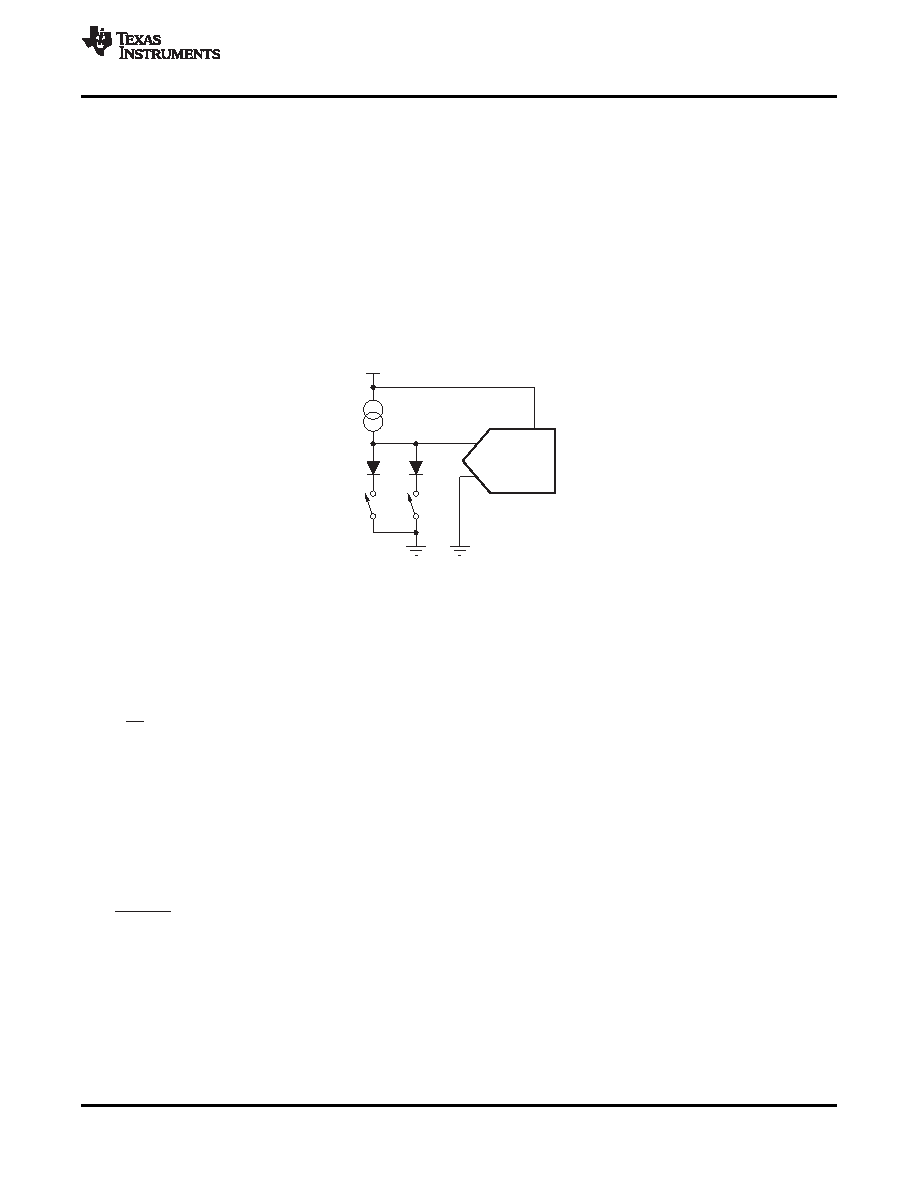- 您現(xiàn)在的位置:買賣IC網(wǎng) > PDF目錄98301 > TSC2008TRGVRQ1 (TEXAS INSTRUMENTS INC) SPECIALTY CONSUMER CIRCUIT, PQCC16 PDF資料下載
參數(shù)資料
| 型號(hào): | TSC2008TRGVRQ1 |
| 廠商: | TEXAS INSTRUMENTS INC |
| 元件分類: | 消費(fèi)家電 |
| 英文描述: | SPECIALTY CONSUMER CIRCUIT, PQCC16 |
| 封裝: | 4 X 4 MM, PLASTIC, VQFN-16 |
| 文件頁(yè)數(shù): | 7/35頁(yè) |
| 文件大小: | 418K |
| 代理商: | TSC2008TRGVRQ1 |
第1頁(yè)第2頁(yè)第3頁(yè)第4頁(yè)第5頁(yè)第6頁(yè)當(dāng)前第7頁(yè)第8頁(yè)第9頁(yè)第10頁(yè)第11頁(yè)第12頁(yè)第13頁(yè)第14頁(yè)第15頁(yè)第16頁(yè)第17頁(yè)第18頁(yè)第19頁(yè)第20頁(yè)第21頁(yè)第22頁(yè)第23頁(yè)第24頁(yè)第25頁(yè)第26頁(yè)第27頁(yè)第28頁(yè)第29頁(yè)第30頁(yè)第31頁(yè)第32頁(yè)第33頁(yè)第34頁(yè)第35頁(yè)

Converter
GND
V
DD
TEMP1
TEMP2
+IN
-IN
GND
REF
DV +
kT
q @ ln(N)
T +
q @ DV
k @ ln(N)
SBAS552
– JUNE 2011
INTERNAL TEMPERATURE SENSOR
In some applications, such as battery recharging, an ambient temperature measurement is required. The
temperature measurement technique used in the TSC2008-Q1 relies on the characteristics of a semiconductor
junction operating at a fixed current level. The forward diode voltage (VBE) has a well-defined characteristic
versus temperature. The ambient temperature can be predicted in applications by knowing the +25
°C value of
the VBE voltage and then monitoring the delta of that voltage as the temperature changes.
The TSC2008-Q1 offers two modes of temperature measurement. The first mode requires calibration at a known
temperature, but only requires a single reading to predict the ambient temperature. The TEMP1 diode, shown in
Figure 24, is used during this measurement cycle. This voltage is typically 580mV at +25
°C with a 10μA current.
The absolute value of this diode voltage can vary by a few millivolts; the temperature coefficient (TC) of this
voltage is very consistent at
–2.1mV/°C. During the final test of the end product, the diode voltage is stored at a
known room temperature, in system memory, for calibration purposes by the user. The result is an equivalent
temperature measurement resolution of 0.3
°C/LSB (1LSB = 610μV with VREF = 2.5V).
Figure 24. Functional Block Diagram of Temperature Measurement Mode
The second mode does not require a test temperature calibration, but uses a two-measurement (differential)
method to eliminate the need for absolute temperature calibration and for achieving 2
°C/LSB accuracy. This
mode requires a second conversion of the voltage across the TEMP2 diode with a resistance 91 times larger
than the TEMP1 diode. The voltage difference between the first (TEMP1) and second (TEMP2) conversion is
represented by:
(3)
Where:
N = the resistance ratio = 91.
k = Boltzmann's constant = 1.3807
× 10–23 J/K (joules/kelvins).
q = the electron charge = 1.6022
× 10–19 C (coulombs).
T = the temperature in kelvins (K).
This method can provide much improved absolute temperature measurement, but a lower resolution of
1.6
°C/LSB. The resulting equation to solve for T is:
(4)
Where:
ΔV = VBE (TEMP2) – VBE(TEMP1) (in mV).
∴ T = 2.573 ΔV (in K),
or T = 2.573
ΔV – 273 (in °C).
Temperature 1 and/or temperature 2 measurements have the same timing as shown in Figure 31 to Figure 34.
Copyright
2011, Texas Instruments Incorporated
15
相關(guān)PDF資料 |
PDF描述 |
|---|---|
| TSC2046EIPWG4 | SPECIALTY CONSUMER CIRCUIT, PDSO16 |
| TSC2046IGQCR | SPECIALTY CONSUMER CIRCUIT, PBGA48 |
| TSC2046IPWR | SPECIALTY CONSUMER CIRCUIT, PDSO16 |
| TSC2046IPW | SPECIALTY CONSUMER CIRCUIT, PDSO16 |
| TSC2046IRGVR | SPECIALTY CONSUMER CIRCUIT, PQCC16 |
相關(guān)代理商/技術(shù)參數(shù) |
參數(shù)描述 |
|---|---|
| TSC2011 | 制造商:TI 制造商全稱:Texas Instruments 功能描述:Nanopower, 4-Wire Resistive Touch and Haptic Controller with I2Ca?¢ Serial Interface |
| TSC2011IRTJR | 制造商:TI 制造商全稱:Texas Instruments 功能描述:Nanopower, 4-Wire Resistive Touch and Haptic Controller with I2Ca?¢ Serial Interface |
| TSC2011IRTJT | 制造商:TI 制造商全稱:Texas Instruments 功能描述:Nanopower, 4-Wire Resistive Touch and Haptic Controller with I2Ca?¢ Serial Interface |
| TSC2011IYZKR | 制造商:TI 制造商全稱:Texas Instruments 功能描述:Nanopower, 4-Wire Resistive Touch and Haptic Controller with I2Ca?¢ Serial Interface |
| TSC2011IYZKT | 制造商:TI 制造商全稱:Texas Instruments 功能描述:Nanopower, 4-Wire Resistive Touch and Haptic Controller with I2Ca?¢ Serial Interface |
發(fā)布緊急采購(gòu),3分鐘左右您將得到回復(fù)。